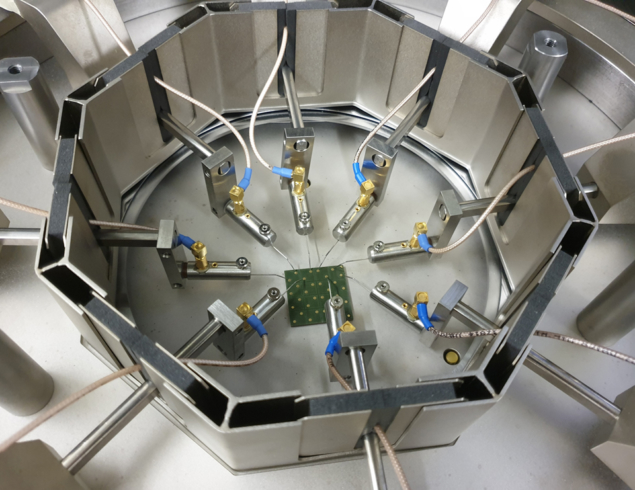
The ever maturing technology of silicon photomultipliers (SiPMs) has a range of advantages over traditional photomultiplier tubes (PMTs). As such, SiPMs are quickly replacing PMTs in a range of physics experiments. The technology is already included in the LHCb SciFi tracker and is foreseen to be used in CMS’ HGCAL, as well as in detectors at proposed future colliders. For these applications the important advantages of SiPMs over PMTs are their higher photo-detection efficiencies (by roughly a factor of two), their lower operating voltage (30-70 V compared to kV’s) and their small size, which allows them to be integrated in compact calorimeters. For space-based instruments — such as the POLAR-2 gamma-ray mission, which aims to use 6400 SiPM channels (see image) — a further advantage is the lack of a glass window, which gives SiPMs the mechanical robustness required during launch. There is, however, a disadvantage with SiPMs: dark current, which flows when the device is not illuminated and is greatly aggravated after exposure to radiation.
In order to strengthen the community and make progress on this technological issue, a dedicated workshop was held at CERN in a hybrid format from 25 to 29 April. Organized by the University of Geneva and funded by the Swiss National Science Foundation, the event attracted around 100 experts from academia and industry. The participants included experts in silicon radiation damage from the University of Hamburg who showed both the complexity of the problem and the need for further studies. Whereas the non-ionizing energy loss concept used to predict radiation damage in silicon is linearly correlated to the degradation of semiconductor devices in a radiation field, this appears to be violated for SiPMs. Instead, dedicated measurements for different types of SiPMs in a variety of radiation fields are required to understand the types of damage and their consequences on the SiPMs’ performance. Several such measurements, performed using both proton and neutron beams, were presented at the April workshop, while plans were made to coordinate such efforts in the future, for example by performing tests of one type of SiPMs at different facilities followed by identical analysis of the irradiated samples. In addition, an online platform to discuss upcoming results was established.
The lack of a glass window gives SiPMs the mechanical robustness required during launch
The damage sustained by radiation manifests itself mainly in the form of an increased dark current. As presented at the workshop, this increase can cause a vicious cycle because the increased current can cause self-heating, which further increases the highly temperature-dependent dark current. These issues are of great importance for future space missions as they influence the power budget, causing the scientific performance to degrade over time. Data from the first SiPM based in-orbit detectors, such as the SIRI mission by the US Naval Research Lab, the Chinese-led GECAM and GRID detectors and the Japanese-Czech GRBAlpha payload, were presented. It is clear that although SiPMs have advantages over PMTs, the radiation, which is highly dependent on the satellite’s orbit, can cause a significant degradation in performance that limits low-earth orbit missions to several years in space. Based on these results, a future Moon mission has decided against the use of SiPMs and reverted to PMTs.
Solutions to radiation damage in SiPMs were also discussed at length. These are mainly in the form of speeding up the annealing of the damage by exposing SiPMs to hotter environments for short periods. Additionally, cooling of the SiPM during data taking will not only decrease the dark current directly, but could also reduce the radiation damage itself, although further research on this topic is required.
Overall, the workshop indicated significant further studies are required to predict the impact of radiation damage on future experiments.





